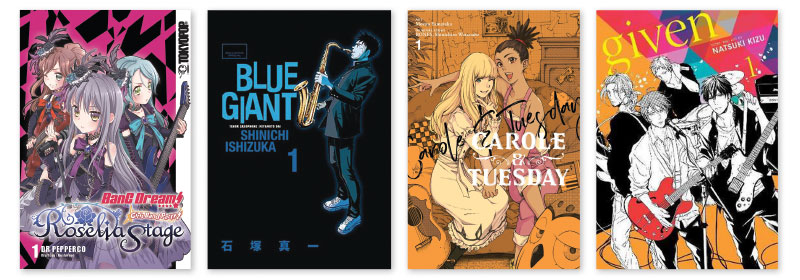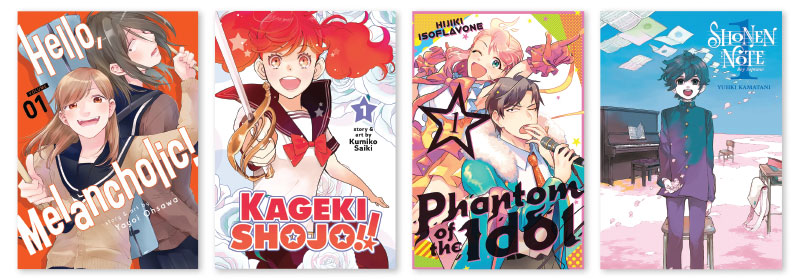8 Pitch-Perfect Manga for Music-Loving Teens | Mondo Manga
Music and performance take center stage in these 8 manga titles for teens.
 Music and musicians are perennially popular for all forms of teen media, including manga. Readers feel strongly about these themes, but they’re a challenge for creators: It’s difficult to depict sounds on a silent page, and just as hard to convey how a performance feels to the listeners and to the musicians. Nonetheless, music is a powerful ingredient in many stories, often drawing people together, sometimes pushing them apart, but always giving shape to their lives. Here’s a look at eight manga that put music center stage.
Music and musicians are perennially popular for all forms of teen media, including manga. Readers feel strongly about these themes, but they’re a challenge for creators: It’s difficult to depict sounds on a silent page, and just as hard to convey how a performance feels to the listeners and to the musicians. Nonetheless, music is a powerful ingredient in many stories, often drawing people together, sometimes pushing them apart, but always giving shape to their lives. Here’s a look at eight manga that put music center stage.

“BanG Dream! Girls Band Party! Roselia Stage” by Dr Pepperco. Tokyopop. 2020–2021.
Gr 8 Up–This series, by the creator of the yuri manga “Goodbye, My Rose Garden,” packs a lot of action and emotion into just two volumes. Yukina wants to form a band and play the main stage at Future World Fes, a major rock festival, a goal that eluded her musician father. Each of the other four girls in the band has her own reason for wanting to join—friendship, sibling rivalry, possibly a crush—but Yukina is firm about staying on task and staying professional. So when she gets an offer from a scout to play at the festival provided she ditches her band, she has some hard thinking to do. The art is super cute, and the characters have big eyes, elaborate hairstyles, and even more elaborate outfits. This fast-moving, emotion-filled story is based on a game that has also been adapted into an anime.
“Blue Giant” by Shinichi Ishizuka. Seven Seas. 2020–2022.
Gr 8 Up–Dai Miyamoto is an ordinary teen with a boring life until he is struck by a sudden passion to play jazz saxophone. Dai goes about learning the sax like any shonen hero facing a challenge: He just takes a saxophone to an isolated spot on a riverbank and plays for hours every day. Dai eventually gets a teacher who knocks off some of his rough edges while grudgingly admitting that Dai is a genius. The day after he graduates high school, Dai departs for Tokyo with no plans and no prospects and teams up with Yushinori, a startlingly original pianist. Tamada, an old friend who has been letting Dai crash at his place, decides to take up the drums, and the three become a trio. Together they head into the Tokyo jazz scene and gradually work their way up. The first two volumes feel almost like a sports manga, with a plucky protagonist beating the odds through sheer stick-to-it-iveness, and even after Dai relocates to Tokyo and forms the band, the musicians are competitive and place great value on physical effort, often driving themselves to extremes. Ishizuka’s art also emphasizes the physical aspects of playing music, making prodigious use of speedlines and sweatdrops, sometimes with musical notes or sound effects swirling around them. Although Dai evangelizes about the icons of jazz, the only present-day Black character doesn’t appear until the final volume. There are also no female musicians, and women are relegated to supporting roles. That said, “Blue Giant” is an astoundingly good manga, and while it is complete in five omnibus volumes, there are two sequel series that have not been licensed in English yet that expand Dai’s world beyond Tokyo.
“Carole and Tuesday” by BONES and Shinichiro Watanabe. illus. by Morito Yamataka. Yen Pr. 2020–2022.
Gr 8 Up–This three-volume manga is set on Mars at a time when artificial intelligence has become a dominant force in the music industry, both as a way of improving music and as a way to replace the musicians and composers who make it. Carole, an orphan living on her own in a big city, and Tuesday, a runaway from a wealthy and powerful family, meet and start making music together. Carole plays keyboard and Tuesday plays guitar, and together they write and sing their own songs. When they sneak into a hall to play a real piano, a video of them goes viral, and soon they are swept up into the music industry, which is filled with colorful characters, including a tough-talking manager with a heart of gold, a ridiculously egotistical DJ, and a steely singer with a cold-blooded manager. Yamataka’s art is clear and naturalistic, with just enough detail to bring the Martian city to life, and the characters are carefully designed and expressive. The themes of the story (the importance of friendship and being true to yourself) are hardly original, but the storytelling is, with plenty of action, a bit of comedy, a few sci-fi touches, and an upbeat ending, making this a truly entertaining read. The series is adapted from the anime of the same name.
“Given” by Natsuki Kizu. SuBLime. 2020–2022.
Gr 11 Up–Romantic tensions crisscross the members of a band in this boys love (BL) manga. Mafuyu is a waiflike teen who shows up in Uenoyama’s life one day with a vague request to teach him to play the guitar he is holding. Uenoyama brings Mafuyu into his band, and as their friendship grows, he realizes that his classmate’s apparent helplessness is linked to a past trauma, the suicide of his middle school boyfriend. Uenoyama begins having confusing feelings toward his new bandmate, and the other two members of the band have some low-key romantic drama going on as well. This first volume starts out slowly, focusing on the different characters and their personalities, which Kizu brings through skillfully, sometimes with a subtle change in eyes or hair. SuBLime is a small publisher that focuses on BL manga, some of it mature and some rated 16+. All six volumes of this manga so far have kept the 16+ rating.

“Hello, Melancholic!” by Yayoi Ohsawa. Seven Seas. 2022.
Gr 8 Up–Minato is a talented trombone player—so talented that she was put into her middle school’s competition band during her first year. After that experience was spoiled by her classmates’ resentment and bullying, she decided she no longer wanted to play in a competitive band. Now in high school, she plays on weekends with an amateur group and does her best to blend in with the others, whether she’s playing music or just trying to be inconspicuous in school. Her classmate Hibiki, on the other hand, is a charming extrovert who is determined to start up a band club at the school and is even more determined to get Minato into it. Hibiki comes on a bit strong, sometimes getting into Minato’s physical space (which strongly hints at the yuri romance that will unfold later), but once Minato starts to give in and plays with the small school group, she is surprised at how much she enjoys playing again and at how well the others accept her. She also finds she really enjoys improvising, and she’s good at it. The artwork is busy but clearly conveys the personalities of the different characters, and Ohsawa captures the energy of the music entirely through their poses and gestures, dispensing with any attempt to include musical notation.
“Kageki Shojo!!” by Kumiko Saiki. Seven Seas. 2020–2022.
Gr 8 Up–This entertaining story follows two girls as they go through the training school for the Kouka acting troupe, which is clearly inspired by the Takarazuka Revue, an all-female musical theater troupe. Watanabe Sarasa is tall, gawky, and enthusiastic about fulfilling her lifelong dream of joining Kouka. Narata Ai is a former singing idol with a traumatic past, who sought out the troupe because it’s an all-female space. In Kageki Shojo!! The Curtain Rises, the prequel to the main series, the two girls start out at odds but eventually become friends, and the story continues to develop in “Kageki Shojo!!” The ensemble cast includes the girls’ classmates, each of whom has a backstory of their own; the second-year students, who mentor the younger girls; and the staff of the school, who are a talented, opinionated bunch. The school is an elite one and the stakes are high, which amps up the usual school drama. The artwork is clear and detailed without being cluttered, and the characters are well defined. This series has all the ingredients of a delightful shojo manga, and the setting really adds to the story. It’s accessible to anyone but is likely to particularly appeal to readers who are already fans of Japanese culture. The series is ongoing, and Seven Seas will release volume 8 in February 2023.
“Phantom of the Idol” by Hijiki Isoflavone. Kodansha. 2022.
Gr 8 Up–Generally, the lead character of a music manga is highly motivated, but Niyodo is the exception to that rule. He’s the laziest male idol singer ever, willing to let his more energetic, more popular partner, Yoshino, do all the work, onstage and off. Motivation finally arrives in the form of a ghost—that of 17-year-old Asahi, a rising young idol who was killed in an accident. Asahi loved being an idol and misses the energy of performance, so she strikes a deal with Niyodo to inhabit his body while he’s practicing and performing. This is a high-energy comedy, and that shows in the artwork, both in the exaggerated depictions of emotion and the little details that make fun of the world of idols (Niyodo has exactly one fan at the beginning). It’s a fast read with plenty of backstage action and over-the-top emotions. The series is ongoing, and Kodansha will release the third volume in December 2022.
“Shonen Note: Boy Soprano” by Yuhki Kamatani. Kodansha. 2022.
Gr 8 Up–Yutaka is 12 years old and starting out as a first-year student in a new middle school. He also has both a beautiful soprano voice and an unusual sensitivity to sounds. The latter is both a blessing and a curse: The noises of the world sound like music to him, and he can hear harmony in his classmates’ laughter, but he can also become overwhelmed. He joins the school choir and immediately inspires them to start performing in contests, but then a well-meaning teacher asks him if he wants to perform in a local opera, which sets up some conflicts and also just overloads him. This manga blends the standard school-story tropes about clubs and rivalries with a new level of storytelling, as other characters accept the very young-looking, very pure-hearted Yutaka but also have to think about their own reactions to him and what that reveals about them. Kamatani is the creator of “Our Dreams at Dusk: Shimanami Tasogare,” and like that story, “Shonen Note” depicts emotions beautifully. Yutaka reads as very young, almost waiflike, especially when he dresses in suspenders and an oversized cap like a Dickensian orphan. The series is complete in eight volumes, with the first one released in October 2022.
Brigid Alverson founded the blog “Good Comics for Kids.” (slj.com/goodcomics).
RELATED
The job outlook in 2030: Librarians will be in demand
The job outlook in 2030: Librarians will be in demand
ALREADY A SUBSCRIBER? LOG IN
We are currently offering this content for free. Sign up now to activate your personal profile, where you can save articles for future viewing





Add Comment :-
Be the first reader to comment.
Comment Policy:
Comment should not be empty !!!